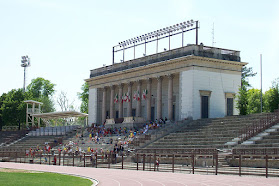Laura Pausini - singer-songwriter
Grammy Award-winner has sold more than 70 million records
One of Italy's best-selling recording artists of all time, pop singer-songwriter Laura Pausini, was born on this day in 1974 in Solarolo, in the province of Ravenna. The first Italian female performer to win a Grammy Award, Pausini's records have sold more than 70 million copies worldwide, more than both Zucchero and Eros Ramazzotti, two giants of Italian popular music. The figure is all the more remarkable for the fact that Pausini has only scratched the surface of the English-language market, which is by far the most lucrative. She records mainly in Italian but has also enjoyed considerable success with recordings in Spanish and Catalan. She is the first non-Spanish artist to sell more than a million copies of a single album in Spain. Pausini's background and upbringing always made it likely she would pursue a career in the music industry. Her father, Fabrizio, is a pianist who played as a session musician for Abba's Anni-Frid Lyngstad and with a group from which was formed the best-selling Italian band Pooh. Later in his career, after he had established himself as a piano bar artist, he encouraged Laura to sing. Read more…
_______________________________________
Mario Monicelli - film director
Life’s work put him among greats of commedia all’italiana
Mario Monicelli, the director who became known as ‘the father of commedia all’italiana’ and was nominated for an Oscar six times, was born on this day in 1915 in Viareggio. He made more than 70 films, working into his 90s. He helped advance the careers of actors such as Vittorio Gassman, Marcello Mastroianni and Claudia Cardinale, and forged successful associations with the great comic actors Totò and Alberto Sordi. Commedia all’italiana was notable for combining the traditional elements of comedy with social commentary, often addressing some of the most controversial issues of the times and making fun of any organisation, the Catholic Church in particular, perceived to have an earnest sense of self-importance. The genre’s stories were often heavily laced with sadness and Monicelli’s work won praise for his particular sensitivity to the miseries and joys of Italian life and the foibles of ordinary Italians. He claimed the lack of a happy ending actually defined Italian humour and that themes drawn from poverty, hunger, misery, old age, sickness, and death were the ones that most appealed to the Italian love of tragi-comedy. Read more…
______________________________________
Massimo Moratti - business tycoon
Billionaire chairman oversaw golden era at Internazionale
The billionaire tycoon and former chairman of Milan’s Internazionale football club, Massimo Moratti, was born on this day in 1945 in Bosco Chiesanuova, a small town in the Veneto about 20km (12 miles) north of Verona. His primary business, the energy provider Saras, of which he is chief executive, owns about 15 per cent of Italy’s oil refining capacity, mainly through the Sarroch refinery on Sardinia, which has a capacity of about 300,000 barrels per day. Moratti is estimated to have net wealth of about €1.28 billion ($1.4 billion) yet is said to have spent close to €1.5 billion of his personal fortune on buying players during his chairmanship of Inter, which lasted from 1995 until 2013 and encompassed a period of unprecedented success. Between 2005 and 2011 Inter won the Serie A title five times, the Coppa Italia and the Supercoppa Italiana four times each, the Champions League once and the FIFA World Club cup once. The five Scudetti came in consecutive seasons from 2006 to 2010, equalling the league record. The only comparable period was the 1960s, when Massimo's father, Angelo, was chairman and Inter won three scudetti and the European Cup, forerunner of the Champions League, twice, with the team known as Grande Inter – ‘the great Inter’. Read more…
______________________________________
Maria Gaetana Agnesi – mathematician
Brilliant scholar gave her time and money to the poor
Maria Gaetana Agnesi, the first woman to write a mathematics handbook, was born on this day in 1718 in Milan. Maria became a mathematician, philosopher, theologian and humanitarian and was also the first woman to be appointed as a mathematics professor at a university. She was one of at least 21 children born to Pietro Agnese, a wealthy man whose family had made their money from silk production. Her mother was his first wife, Anna Fortunato Brivio, who was from a noble Milanese family. Maria was soon recognised as a child prodigy, who could speak Italian and French by the time she was five and had learnt Greek, Hebrew, Spanish, German and Latin by the time she was 11. When she became ill at the age of 12, it was thought to have been because of excessive studying and reading, but after she was prescribed vigorous dancing and horse riding to improve her health, she suffered convulsions and was then advised to moderate her activities. By the time Maria was 14 she was studying ballistics and geometry. Her father regularly invited learned men to his house to listen to her read and to discuss philosophical questions with her. Read more…



_Gaetana_Agnesi.jpg)



.jpg)
.jpg)

_-_n._3901_-_Milano_-_Arena_(alternative_take).jpg)






.jpg)